Rasp Fern
(Doodia media)
Rasp Fern (Doodia media)
/
/

Avenue
CC BY-SA 3.0
Image By:
Avenue
Recorded By:
Copyright:
CC BY-SA 3.0
Copyright Notice:
Photo by: Avenue | License Type: CC BY-SA 3.0 | License URL: https://creativecommons.org/licenses/by-sa/3.0 | Uploader: Rotatebot | Publisher: Wikipedia Commons




















Estimated Native Range
Climate Requirements for Madera, California
| This Plant | Your Site | Plant Suitability for Your Location | ||
|---|---|---|---|---|
| • Precipitation | 6" - 300" | 11" | Your precipitation may be insufficient for this plant. Irrigate N" / year. | Irrigate N" / year |
| • High Temp. | 61°F - 101°F | 97°F | Your summer temperatures are normal for this plant. | Excellent |
| • Low Temp. | 13°F - 67°F | 35°F | Your winter temperatures are normal for this plant | Excellent |
This plant should grow well at your location with about N inches per year (Y minutes per month) of irrigation.
Summary
Doodia media, commonly known as Rasp Fern, is an evergreen fern native to the understory of moist forests and shaded stream banks in Australia, New Zealand, and some Pacific Islands. It typically grows to a height and width of 1-3 feet (0.3-0.9 meters), featuring upright fronds that are initially pinkish-red, maturing to a deep green. The fronds are narrow, with a rough texture that gives the plant its common name. Rasp Fern blooms inconspicuously, as ferns do not produce flowers, but its new fronds’ color can add visual interest to shady garden areas.
Rasp Fern is valued for its textured foliage and the contrast its new growth provides against the mature green fronds. It is often used in shaded garden beds, as ground cover, or in container plantings. This fern thrives in humus-rich, well-drained soil and requires consistent moisture without waterlogging. It is relatively low maintenance but benefits from the removal of old fronds to maintain a tidy appearance. While it is not prone to serious pests or diseases, overwatering can lead to root rot. Rasp Fern is not known to be invasive and is a suitable choice for gardeners looking to add a lush, ferny texture to their shade gardens.CC BY-SA 4.0
Rasp Fern is valued for its textured foliage and the contrast its new growth provides against the mature green fronds. It is often used in shaded garden beds, as ground cover, or in container plantings. This fern thrives in humus-rich, well-drained soil and requires consistent moisture without waterlogging. It is relatively low maintenance but benefits from the removal of old fronds to maintain a tidy appearance. While it is not prone to serious pests or diseases, overwatering can lead to root rot. Rasp Fern is not known to be invasive and is a suitable choice for gardeners looking to add a lush, ferny texture to their shade gardens.CC BY-SA 4.0
Plant Description
- Plant Type: Fern
- Height: 1-3 feet
- Width: 1-3 feet
- Growth Rate: Moderate
- Flower Color: N/A
- Flowering Season: Non-Flowering
- Leaf Retention: Evergreen
Growth Requirements
- Sun: Part Shade, Full Shade
- Water: Medium
- Drainage: Slow, Medium
Common Uses
Deer Resistant, Groundcover, Low Maintenance, Potted Plant, Rock Garden
Natural Habitat
Moist forests and shaded stream banks in Australia, New Zealand, and some Pacific Islands
Other Names
Common Names: Pukupuku
Scientific Names: Blechnum medium, Doodia media, Doodia connexa, Doodia lunulata, Woodwardia media, Doodia caudata var. media, Woodwardia lunulata, Doodia aucklandica, Doodia caudata f. triloba
GBIF Accepted Name: Doodia media R.Br.